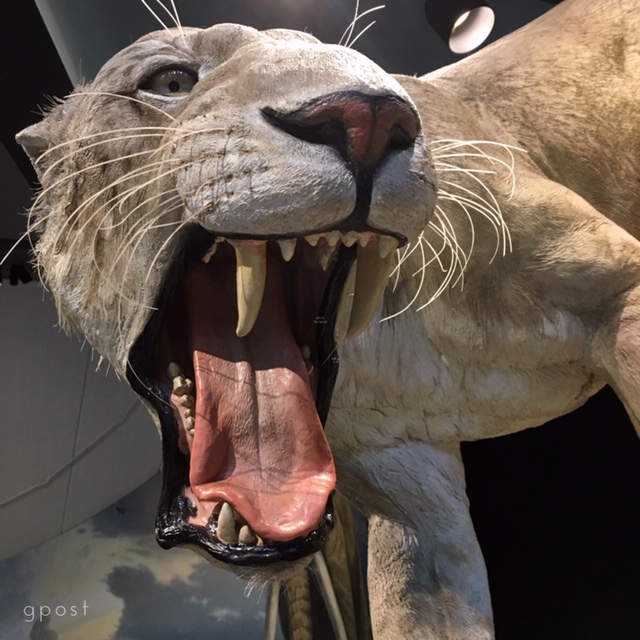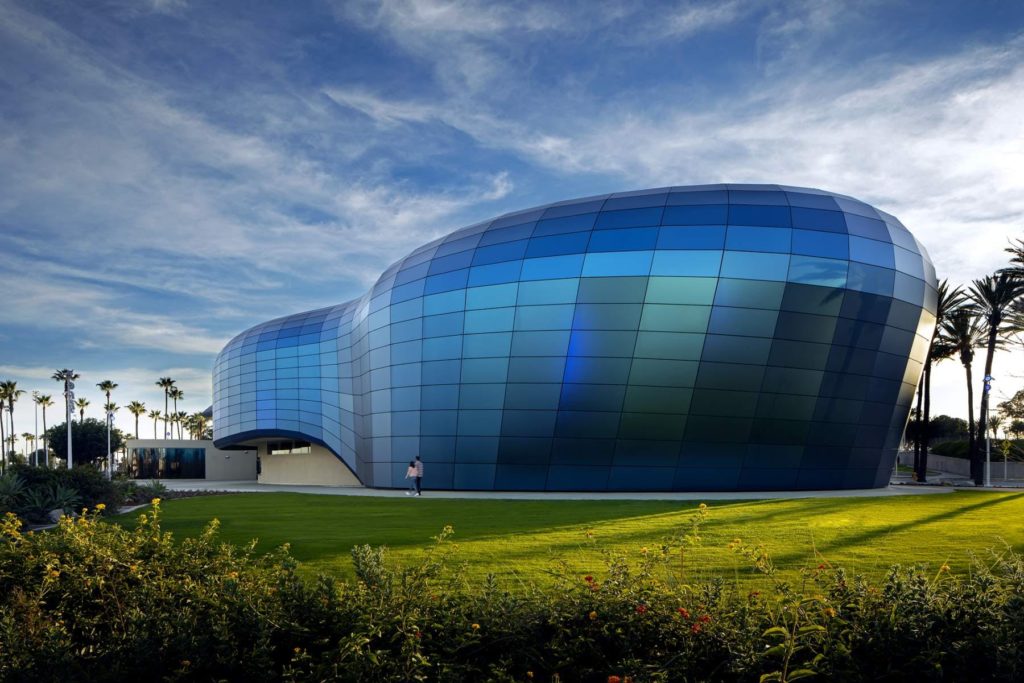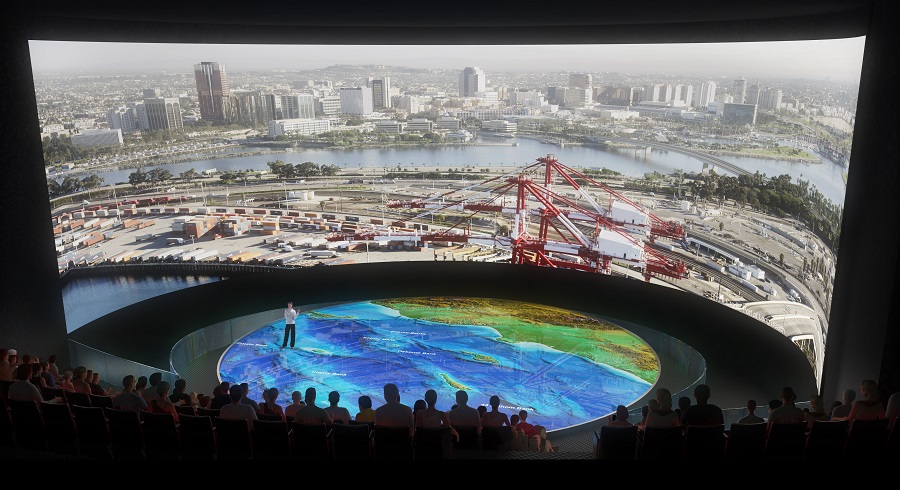
The future seemed closer in California than it does in Philadelphia where I’m writing this post. California also seemed to be having a more active conversation with its past, despite there being historical touchstones like the Liberty Bell and Independence Hall only a couple of miles from me. Californians seemed to have a deeper sense of where humans have been already and where we are headed in our lifetimes and beyond.
I’ve just gotten back from Los Angeles, so some of it may be my wandering state of mind. But the West Coast, and California in particular, was also the hoped-for destination of our landlocked frontier, where the promise of a transcontinental crossing would either be realized by generations of settlers or dashed. It’s where America faces the rising East, the part that turns its back on the confusion and stalemate of Washington and dares to propose solutions.
How much we let the distant past reverberate into an equally distant future—how much or how little we can escape our fixation with “the way that we feel right now”—this flow of time (or the lack of it) impacts the perspective we bring to everything we do, worry about, want to accomplish and leave behind for our kids to enjoy.
Despite its rep for seeking shallow gratifications in the here and now, at least some of California seemed to be looking back, almost to our beginnings, for clues on how the human race has gotten to this fragile and deeply compromised place. These time travelers seem to know that if we fail to understand our past and learn from it, we may never know that we’re repeating the same mistakes when we could be avoiding them.
They also see the future differently. At least some Californians seem to understand that by focusing almost exclusively on the present, we are neglecting problems whose consequences are likely to endure for decades if not centuries. On a timescale that includes our children, our children’s children, their children and beyond, they seem to be saying: we are responsible for addressing these problems because of the roles we have played in creating them. These adults seem to understand that in order to claim the future we want for ourselves and our descendants, we need to expand our perspective on time to include humanity’s full passage on earth, from the triumphs and tragedies that have brought us to today to the long-term future that’s worth working and sacrificing for.
And because it’s California after all, they’ve done this by creating richly entertaining destination experiences.

1. The La Brea Tar Pits
More than 10,000 years ago, during the Pleistocene Age, enormous mammals (so-called megafauna) coexisted for a time with some of the earliest humans. These were mammoths, mastodons, giant bison, dire wolves, sloths with foot-long claws, six-foot tall beavers “with incisors like medieval weapons,” and saber-tooth cats. Their enormous size was a response to the cold climate. A warm climate produces smaller bodies that expel heat while glacial intervals during the Pleistocene encouraged extra layers of bone, fat and fur with a smaller ratio of surface area to volume and a greater ability to hold in body heat. The scale of this engineering feat was enormous, with the largest mammoths weighing in at around ten tons, or three tons more than the largest African elephants today.
These megafauna lived in the cold, grassy plains that extended below the ice shelf in North America, from coast to coast. In certain places where oil pooled at ground level producing a kind of asphalt or tar, these mammals were drawn to the thin layers of water that accumulated just above the tar when they were thirsty and wanted to drink. As they sought out the water, individual animals became trapped in the tar. Other predators, drawn by their distress, also became trapped. Before long, these tar pits become the mass graveyards of the Pleistocene age.
The La Brea Tar Pits are located along Wilshire Boulevard in the center of LA. Preserved in them, researchers have discovered one of the largest repositories of Pleistocene megafauna in the world. They have also found important clues about how these massive animals disappeared altogether and the Holocene—or our next geological age—began.
For years, the speculation was that rapid climate change or disease led to extinction of the megafauna, and both likely contributed to it. But bands of humans shared these grassy plains with these giant mammals. Our ancestors had a competitive sense of conquest and adventure, and they needed to feed their growing families.
In his Atlas of a Lost World, Craig Childs describes the struggle of man versus megafauna in an arresting but ambivalent way:
This is a love story—boy meets girl, if you will. One partner is a [largely] unpeopled hemisphere, the other is our hungry, inquisitive species. Some might tell you that the encounter wasn’t love at all, but domination, overkill, an invasive species hell-bent on spreading into a land that was doing just fine as it was, without us. Some scientists have called it blitzkrieg, mammoths felled like cordwood. Ours was no docile species, and the animals were not ready for us, or our weaponry. Archeologists from Alaska to Florida have found Paleolithic spearpoints and stone blades still holding protein signatures from the meat of horse, camel, sloth, bison, bear and the proboscideans, mammoths and mastodons. Ice Age bones in the Americas have been found scribed with human butchering marks, blackened from fires. But humans didn’t always win. Many died, some were eaten. First people, wildly outnumbered by animals, would have found themselves tossed and trampled by tusks and hooves or torn to pieces by the scissoring teeth of scimitar cats. No matter how well armed they were, even with Eurasian wolf dogs at their sides, surviving among Rancholabrean megaflora would have been challenging. Nobody said love would be easy.
These encounters were difficult, but in the end the human hunters with their always improving weapons were smarter, more tenacious and more powerful. The scientists and researchers at the La Brea Tar Pits and elsewhere have concluded that it was neither climate nor disease that led to the mass extinction of the megafauna. Whether love story (human drive and ingenuity) or tragedy (a human “blitzkrieg”), mankind triumphed over nature by wiping these enormous animals from the face of the earth.
Parallels between the annihilation of mammoths and mastodons and of entire species today due to over-hunting, over-fishing, pollution, and loss of habitat are hardly exact. Similarly, there will always be uncertainties about what happened 10,000 years ago. But the human drives (for better and worse) that contributed to these extinctions are the same. Nature is no match for man’s desire and ability to take whatever he can from it, as quickly and efficiently as he can.
During the Pleistocene, humans killed off the megafauna. During our Holocene, the same motivations nearly exterminated the American bison (from a herd of 60 million in 1800 to only a few hundred 90 years later).
Today, mankind is likely in a new geoglogical era called the Anthropocene. For the very first time in our checkered history, human activity is exerting the dominant influence on both climate and the environment.
Can we learn lessons from the past about how to constrain our best and worst impulses so that we neither “love” nor “dominate” our earthly home to death?
Are we able to look back—sometimes very far back—to learn as much as we can about ourselves and our impacts when once again we are pushing the world around us to the brink?
Can our minds hold a broad enough perspective of time for that?

2. Pacific Visions
Two weeks ago, the new Pacific Visions building opened as part of the existing aquarium complex in Long Beach, just outside LA. While its biomorphic curves “shimmer like the ocean” on the outside, it’s the future of the Earth’s oceans, its life forms and our human interactions with them that are the focus of its programming.
Visitors are engaged by several of our oceans’ current challenges and opportunities in the Pacific Visions theater with its surround screen and multisensory effects that include wind, fog, strobe lights, seat rumblers and blasts of ocean-related scents. There is high resolution footage of sea creatures, animations, computer graphics as well as images of what cities and other ocean-facing human landscapes look like today and might look like tomorrow. In other words, visitors can quite literally “sense” our current predicament and some of the ways that we have begun to confront it. The theater is both immersive and enabling, inspiring viewers “to think creatively about out global future” while beginning to see themselves as the oceans’ “stewards.”
The theater empties into the Culmination Gallery which lets visitors try their hands at ocean stewardship by making the ethical choices and trade-offs that will be required to restore specific California ecosystems many of them are familiar with already. For groups, there are interactive game tables themed around food, energy and water that invite as many as ten players to make a sequence of choices while working together to create enough of each resource to sustain California’s residents into the future.
There are animal exhibits, including one profiling yellowtail a fish native to California’s coastal waters. It demonstrates how the fish could be raised in offshore farms to produce as much protein as beef or pork but with far less harmful environmental impacts. Another project that promises a healthier future involves Pacific and Olympia oysters. Visitors learn how oyster farming can stabilize erosion-prone shorelines while filtering and cleaning the waters that are closest to population areas.
“Future City Fly-Through” uses touch screen controls on wall screens to “fly” visitors through a virtual city while they explore innovations reducing water usage in a drought-prone locales like California and using ocean water in unfamiliar ways. Opportunities for exploration include vertical farming methods and the utilization of desalination plants.
Admittedly, several of the experiences offered at Pacific Visions are also available in online simulations, but our hosts seemed to know that most players will choose a game like Fortnite instead of having an educational experience during their personal screentime. So Pacific Visions offers a destination-based alternative, employing technology to provide an immersive experience that enables visitors to do the serious work of designing their futures in inherently playful ways.
Unless there are more “active environmentalists” among Americans than there are today, confronting the challenge of climate change will be nearly impossible.
With its $53 million cost and 29,000 square foot destination, Pacific Visions is aiming for every recruit it can enlist among school children, vacationers, day trippers, and those who already support sustainability with their hearts but not so much with their actions.
In a recent post, I argued for the strategy of relying upon respected leaders whose own minds have been changed about the significance of climate change in the light of their Republican or Libertarian values to reach out to skeptics in their own communities with the same arguments that persuaded them. Common values will give those arguments a hearing while the entreaties of “tree huggers” with different priorities continue to fall on deaf ears. Californians are being similarly strategic with their investment dollars and objectives at Pacific Visions. They are seeking recruits to help design a healthier future for our oceans by packaging their serious purpose along with the fun of a day spent at Disneyland.

3. More Hurdles Ahead
California in general and LA in particular seemed poised between the distant past and the un-designed future that extends for generations in front of us. Getting out of the present and deepening our perspective of time clarifies what is truly important while gaining the wisdom from our mistakes, even when they happened in the last geological age or will only be felt by our great, great grandchildren.
The practical work of designing the future causes us to confront what we don’t know, what others around us are failing to appreciate, and how to deepen the understanding that stewardship requires. In researching this post, I came upon a short list compiled by the FrameWorks Institute called “Gaps in Understanding” between what the experts know about the current threats to our oceans and what the general public knows. As Pacific Visions evolves its educational programming and other forward-thinking institutions follow its lead, here are some of the gaps in public understanding that need to be bridged if we are to find a more sustainable future for our water world:
– most people see the oceans as vast, undifferentiated bodies of water instead of supporting vastly different ecosystems with different temperatures, currents and habitats;
– the public doesn’t understand how global warming is disrupting currents and temperatures in both the atmosphere and the oceans and how these disruptions are contributing to the extreme weather many of them have been experiencing;
– people believe that most ocean pollution consists of plastic waste. By failing to understand the extent of pollution caused by our much larger systems of manufacturing, consumption, transportation and energy usage, they are unable to explore the kinds of solutions that are needed to stop the continuing pollution of our oceans;
– because the public believes that the oceans’ vast capacity effectively reduces the negative consequences of human activity, it fails to grasp either the complexity or severity of the challenges to the oceans’ diverse biosystems;
– members of the public have some understanding of the risks to particular ocean animals (like sea turtles) but fail to appreciate how overfishing, acidification and rising water temperatures are threatening the extinction of entire species;
– people lack a clear understanding of the role that national governments can and should play, either acting on their own or in concert with other national governments. This results in “a largely empty assignment of responsibility” for addressing the oceans’ declining prospects.
– when the public thinks about “what can be done,” it focuses on modifying individual behavior (like more recycling) instead of implementing systematic solutions like expanding and enforcing marine protected areas, reforming the commercial fishing industry, regulating and enforcing pollution controls, enforcing carbon emission limits, and incorporating “ocean protection” into school curricula and government policymaking.
To design a sustainable future, we need to close the gaps between what the experts and the rest of us seem to know.
These gaps in basic knowledge speak to the extent of the educational and motivational hurdles that are ahead of us as we confront the onset of climate change on land as well as sea.
Escaping the gratifications and distractions of the present and gaining the perspective of time–its long-term lessons as well as its long-term consequences and possibilities—provides some of the incentive to fill in these gaps in our knowledge.
It’s the yeoman’s task that the educators and entertainers at the La Brea Tar Pits and Pacific Visions are already taking on.
This post was adapted from my June 9, 2019 newsletter. When you subscribe, a new newsletter/post will be delivered to your inbox every Sunday morning.
Leave a Reply